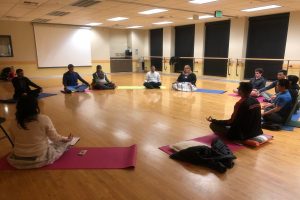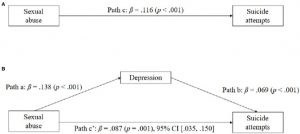Improve Pain, Sleep, and the Mental Health of Chronic Pain Patients with Internet Mindfulness Training
By John M. de Castro, Ph.D.
“In the context of chronic pain . . . meditation can help you to stop your mind wandering back to your pain when you are trying to focus on something else, therefore improving your ability to give your entire attention to the task at hand and in turn, improve your level of functioning. It gives you the power to take your mind off your pain and refocus it, therefore aiding you in replacing unhelpful, behaviours with healthy ones which can reduce your pain and allow you to take better care of your health.” – Ann-Marie D’arcy-Sharpe
We all have to deal with pain. It’s inevitable, but hopefully it’s mild and short lived. For a wide swath of humanity, however, pain is a constant in their lives. At least 100 million adult Americans have chronic pain conditions. The most common treatment for chronic pain is drugs. These include over-the-counter analgesics and opioids. But opioids are dangerous and highly addictive. Prescription opioid overdoses kill more than 14,000 people annually. So, there is a great need to find safe and effective ways to lower the psychological distress and improve the individual’s ability to cope with the pain.
There is an accumulating volume of research findings that demonstrate that mindfulness practices, in general, are effective in treating pain. A therapeutic technique that contains mindfulness training and Cognitive Behavioral Therapy (CBT) is Acceptance and Commitment Therapy (ACT). It focuses on the individual’s thoughts, feelings, and behavior and how they interact to impact their psychological and physical well-being. It then works to change thinking to alter the interaction and produce greater life satisfaction. ACT employs mindfulness practices to increase awareness and develop an attitude of acceptance and compassion in the presence of painful thoughts and feelings. ACT teaches individuals to “just notice”, accept and embrace private experiences and focus on behavioral responses that produce more desirable outcomes.
Acceptance and Commitment Therapy (ACT) requires a scheduled program of sessions with a trained therapist. This results in costs that many clients can’t afford. In addition, the participants must be available to attend multiple sessions at particular scheduled times that may or may not be compatible with their busy schedules and at locations that may not be convenient. As an alternative, mindfulness training over the internet have been developed. These have tremendous advantages in decreasing costs, making training schedules much more flexible, and eliminating the need to go repeatedly to specific locations. In addition, research has indicated that mindfulness training online can be effective for improving the health and well-being of the participants.
In today’s Research News article “Internet‐delivered acceptance and commitment therapy as microlearning for chronic pain: A randomized controlled trial with 1‐year follow‐up.” (See summary below or view the full text of the study at: https://onlinelibrary.wiley.com/doi/10.1002/ejp.1723 ) Rickardsson and colleagues recruited adult chronic pain patients and randomly assigned them to either a wait-list control condition or to receive an 8-week program of Acceptance and Commitment Therapy (ACT) delivered over the internet. ACT was delivered in daily microlearning short learning interactions. There was a 74% completion rate of the modules. The participants were measured before and after training and at 3-, 6-, and 12-month follow-ups for psychiatric problems, pain interference, pain intensity, anxiety, depression, psychological inflexibility, values, and health-related quality of life.
They found that compared to baseline and the wait-list control group, the group that received internet-delivered Acceptance and Commitment Therapy (ACT) had significant decreases in pain interference, pain intensity, anxiety, depression, psychological inflexibility, value obstruction, and insomnia. These improvements were long-lasting as they were maintained at the 12-month follow-up.
These are impressive improvements in the pain and psychological health of these diverse chronic pain patients. These results correspond with the frequent prior observations that mindfulness training produces reductions in pain, anxiety, depression, psychological inflexibility, and insomnia in a wide range of patient types and normal individuals. These results are particularly impressive as Acceptance and Commitment Therapy (ACT) was delivered over the internet. in daily microlearning short learning interactions. This was very convenient for the patients and required only 12.4 minutes per week of therapist time per week and was thus very inexpensive to deliver. Yet ACT was highly effective and lasting in relieving the suffering of these chronic pain patients.
So, improve pain, sleep, and the mental health of chronic pain patients with internet mindfulness training.
“What we want to do as best as we can is to engage with the pain just as it is. It’s not about achieving a certain goal – like minimizing pain – but learning to relate to your pain differently.” – Elisha Goldstein
CMCS – Center for Mindfulness and Contemplative Studies
This and other Contemplative Studies posts are also available on Google+ https://plus.google.com/106784388191201299496/posts and on Twitter @MindfulResearch
Study Summary
Jenny Rickardsson, Charlotte Gentili, Linda Holmström, Vendela Zetterqvist, Erik Andersson, Jan Persson, Mats Lekander, Brjánn Ljótsson, Rikard K. Wicksell. Internet‐delivered acceptance and commitment therapy as microlearning for chronic pain: A randomized controlled trial with 1‐year follow‐up, European Journal of Pain, 2021;00:1–19, https://doi.org/10.1002/ejp.1723
Abstract
Background
Studies of Internet‐delivered acceptance and commitment therapy (ACT) for chronic pain have shown small to moderate positive effects for pain interference and pain acceptance. Effects on pain intensity, depression, anxiety and quality of life (QoL) have been less favourable, and improvements for values and sleep are lacking. In this randomized controlled trial iACT – a novel format of Internet‐ACT using daily microlearning exercises – was examined for efficacy compared to a waitlist condition.
Methods
Adult participants (mean age 49.5 years, pain duration 18.1 years) with diverse chronic pain conditions were recruited via self‐referral, and randomized to iACT (n = 57) or waitlist (n = 56). The primary outcome was pain interference. The secondary outcomes were QoL, depression, anxiety, insomnia and pain intensity. The process variables included psychological inflexibility and values. Post‐assessments were completed by 88% (n = 100) of participants. Twelve‐month follow‐up assessments were completed by 65% (iACT only, n = 37). Treatment efficacy was analysed using linear mixed models and an intention‐to‐treat‐approach.
Results
Significant improvements in favour of iACT were seen for pain interference, depression, anxiety, pain intensity and insomnia, as well as process variables psychological inflexibility and values. Between‐group effect sizes were large for pain interference (d = 0.99) and pain intensity (d = 1.2), moderate for anxiety and depressive symptoms and small for QoL and insomnia. For the process variables, the between‐group effect size was large for psychological inflexibility (d = 1.0) and moderate for values. All improvements were maintained at 1‐year follow‐up.
Conclusions
Internet‐ACT as microlearning may improve a broad range of outcomes in chronic pain.
Significance
The study evaluates a novel behavioral treatment with positive results on pain interference, mood as well as pain intensity for longtime chronic pain sufferers. The innovative format of a digital ACT intervention delivered in short and experiential daily learnings may be a promising way forward.
https://onlinelibrary.wiley.com/doi/10.1002/ejp.1723








